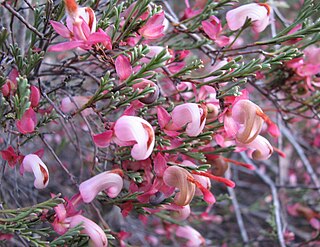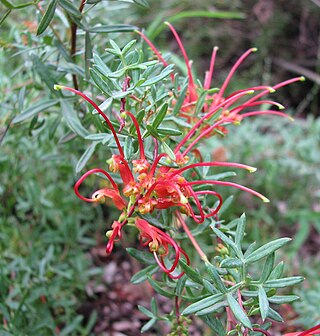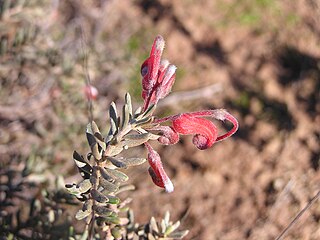
Grevillea curviloba is a species of flowering plant in the family Proteaceae and is endemic to the south-west of Western Australia. It is a prostrate to erect shrub with short branchlets, divided leaves with linear to narrowly lance-shaped lobes with the narrower end towards the base, and white to cream-coloured flowers.

Grevillea involucrata, also known as Lake Varley grevillea, is a species of flowering plant in the family Proteaceae and is endemic to the south-west of Western Australia. It is an openly-branched, prostrate or low-lying shrub with divided leaves with parallel, oblong to linear lobes, and pink flowers with a pinkish-red style.

Grevillea ripicola, commonly known as Collie grevillea, is a species of flowering plant in the family Proteaceae and is endemic to the South West region of Western Australia. It is a dense, spreading shrub with pinnatipartite leaves with rigid, sharply-pointed lobes, and clusters of yellowish-orange flowers, usually with a red style.

Grevillea integrifolia, commonly known as entire-leaved grevillea, is a species of flowering plant in the family Proteaceae and is endemic to the south-west of Western Australia. It is an erect shrub with egg-shaped leaves, the narrower end towards the base, and cylindrical clusters of white to creamy-white flowers.

Grevillea diversifolia, the variable-leaved grevillea, is a species of flowering plant in the family Proteaceae and is endemic to the south-west of Western Australia. It is an erect to prostrate shrub with simple or divided leaves and groups white to cream-coloured flowers with a dull red style.

Grevillea maccutcheonii, commonly known as McCutcheon's grevillea, is a species of flowering plant in the family Proteaceae and is endemic to a single location in the south-west of Western Australia. It is a densely-branched shrub with three-lobed, stem-clasping leaves, and clusters of reddish-green flowers. The total population of the species was estimated in 2007 to be seven mature plants.
Grevillea kirkalocka is a species of flowering plant in the family Proteaceae and is endemic to inland Western Australia. It is a low, spreading shrub with divided leaves with sharply-pointed linear lobes and clusters of red flowers.

Grevillea plurijuga is a species of flowering plant in the family Proteaceae and is endemic to southern Western Australia. It is a prostrate to low-lying or dense mounded to erect shrub with divided leaves with linear lobes and loose clusters of hairy, red or pink flowers.

Grevillea dryandroides, commonly known as phalanx grevillea, is a species of flowering plant in the family Proteaceae and is endemic to the south-west of Western Australia. A diffuse, clumping shrub, it often forms suckers and has divided leaves with up to 35 pairs of leaflets, and groups of red to pinkish flowers on an unusually long, trailing peduncle.

Grevillea amplexans is a species of flowering plant in the family Proteaceae and is endemic to the Mid West region of Western Australia. It is a spreading shrub with arching branches, stem-clasping, sharply-pointed, lobed or toothed leaves and white to cream-coloured flowers.
Grevillea berryana is a species of flowering plant in the family Proteaceae and is endemic to the Pilbara, Mid West and Goldfields regions of Western Australia. It is a shrub or tree with mostly divided leaves with linear lobes and clusters of pale cream-coloured to yellow flowers.

Grevillea coccinea is a species of flowering plant in the family Proteaceae and is endemic to the south of Western Australia. It is a low-lying or sprawling shrub with narrowly wedge-shaped to linear leaves and white, cream-coloured, and red or yellow flowers.

Grevillea obliquistigma is a species of flowering plant in the family Proteaceae and is endemic to the south-west of Western Australia. It is a spreading shrub with linear leaves, and conical to cylindrical clusters of creamy-white to yellowish cream-coloured flowers, sometimes tinged with pink.

Grevillea patentiloba is a species of flowering plant in the family Proteaceae and is endemic to the south-west of Western Australia. It is a prostrate to erect, spreading to straggling shrub with divided leaves, and down-turned clusters of red to deep pink and cream-coloured to bright yellow flowers with a red to deep pink style.
Grevillea prominens is a species of flowering plant in the family Proteaceae and is endemic to a restricted part of the South West region of Western Australia. It is a shrub with divided leaves, the end-lobes linear to narrow triangular, and creamy-white flowers usually projected beyond the foliage.

Grevillea pythara, commonly known as Pythara grevillea, is a species of flowering plant in the family Proteaceae and is endemic to a restricted part of the South West region of Western Australia. It is a low, suckering shrub with linear to narrowly elliptic leaves and small groups of red flowers.

Grevillea rara, also known as the rare grevillea, is a species of flowering plant in the family Proteaceae and is endemic to a restricted part of the South West region of Western Australia. It is a prostrate, sprawling shrub when young, later a dense, prickly shrub with pinnatisect leaves with linear lobes, and clusters of white to pale pink flowers.
Grevillea rogersoniana, commonly known as Rogerson's grevillea, is a species of flowering plant in the family Proteaceae and is endemic to a restricted area near Shark Bay in Western Australia. It is an erect shrub with spatula-shaped leaves with 3 to 5 teeth or shallow lobes on the end, and cylindrical clusters of reddish pink flowers, the style with a cream-coloured tip.

Grevillea uniformis is species of flowering plant in the family Proteaceae and is endemic to the south-west of Western Australia. It is a shrub with broadly egg-shaped to fan-shaped leaves with sharply tipped teeth or lobes, and more or less spherical clusters of white flowers.
Grevillea saxicola is a species of flowering plant in the family Proteaceae and is endemic to the Pilbara region of Western Australia. It is a shrub or small tree usually with pinnatisect leaves with linear lobes, and cylindrical clusters of cream-coloured to pale yellow flowers.
















